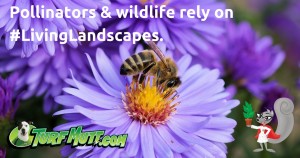Latest Posts
- Have a purpose when backyardingAugust 5 2021
- Study: Time outside alters our microbiomeAugust 4 2021
- Happy National Mutt Day from Mo-MoJuly 27 2021
- New home? Avoid these common mistakes in your yard.July 26 2021
- Infographic: Plan a backyard staycation this summerJuly 22 2021
Categories
Archive
January 31st
Professor Botany is TurfMutt’s smarty-pants sidekick and the bushy-tailed brains of the Outdoor Powers. Professor Botany busies herself on the back end of the Outdoor Powers’ missions. She maps out the “greening” plans for the Outdoor Powers, and teaches kids about plants from the comfort of her lofty tree nest.
This spring, Professor Botany encourages you to learn about your climate zone and plant living landscapes to feed and house special pollinator and wildlife friends.
Professor Botany’s Primer on Pollinators & Living Landscapes
- Nature starts in your backyard.
Yards, parks, schoolyards and other community green space are vital to the world’s ecosystem. - Pollinators & wildlife rely on living landscapes.
Grass, trees, shrubs and other plant life provide food and habitat for birds and small mammals. Insects, spiders and worms live among the grass blades and below the surface in the turf. - Lack of living landscapes = lack of biodiversity.
Replacing living landscapes with rocks, mulch, plastic grass and hardscapes forces birds, squirrels and other animals to forage for food elsewhere. By eliminating living landscapes from urban and suburban life, birds, pollinators and wildlife lose their home habitat.
So, what can you do to help insects and other important backyard critters? Professor Botany has some tips.
- Know your climate zone and add more plants that do well in the environment, which will make our communities nicer places to live for families, pets and wildlife.
- Seek a good balance of climate-appropriate, drought friendly grasses, plants trees and shrubs. This will benefit the local wildlife and the environment overall.
- Add some pollinator plants to your yard to attract bees, butterflies, hummingbirds and other pollinating wildlife.
Learn more about the importance and benefits of living landscapes by visiting LivingLandscapesMatter.com.






